Earl's Court is a district of Kensington in the Royal Borough of Kensington and Chelsea in West London, bordering the rail tracks of the West London line and District line that separate it from the ancient borough of Fulham to the west, the sub-districts of South Kensington to the east, Chelsea to the south and Kensington to the northeast. It lent its name to the now defunct eponymous pleasure grounds opened in 1887 followed by the pre–World War II Earls Court Exhibition Centre, as one of the country's largest indoor arenas and a popular concert venue, until its closure in 2014.

The Roof Gardens is a private roof garden covering 6,000 square metres (65,000 sq ft) on top of the former Derry & Toms building on Kensington High Street in central London.

Gloucester Road is a street in the Royal Borough of Kensington and Chelsea, London. It runs north–south between Kensington Gardens and Old Brompton Road.

Hans Place is a garden square in the Knightsbridge district of the Royal Borough of Kensington and Chelsea, London, immediately south of Harrods in SW1. It is named after Sir Hans Sloane, 1st Baronet, PRS, physician and collector, notable for his bequest, which became the foundation of the British Museum.

Hinton Admiral is the estate and ancestral home of the Tapps-Gervis-Meyrick family and located in the settlement of Hinton, near Bransgore in Hampshire, England. It is a Grade I Listed building.
Thomas Cundy III was a British architect. He joined his father's practice in the 1840s and was also surveyor of the Grosvenor Estate, London. He retired from that post in 1890, and was succeeded by Eustace Balfour.

Onslow Square is a garden square in South Kensington, London, England.
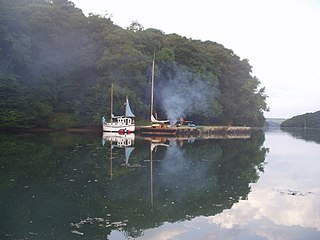
Tremayne is a hamlet in the parish of St Martin in Meneage, Cornwall, England, United Kingdom.

Pelham Crescent is a circa 1825 Georgian crescent of houses in South Kensington, London SW7, England, designed by architect George Basevi. Numbers 1–14 and 15–27 are separately Grade II* listed.

Edwardes Square is a garden square in Kensington, London, W8. The square was built between 1811 and 1820. 1–23 and 25–48 Edwardes Square are listed Grade II for their architectural merit.

The Gloucester Arms is a Grade II listed pub at 34 Gloucester Road, Kensington, London SW7, built in the 19th century. It is owned by Greene King.

56–58 Queen's Gate Terrace is a pair of Grade II listed houses in Queen's Gate Terrace, Kensington, London SW7, built in 1863–65 by the architect Charles Gray.

The Anglesea Arms is a pub at 15 Selwood Terrace, South Kensington, London SW7.
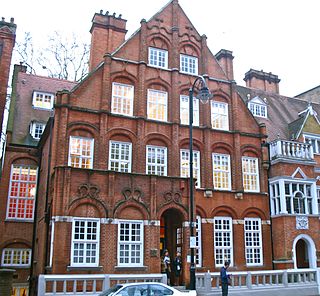
Harrington Gardens is a street which has a communal garden regionally sometimes known as a garden square in the Royal Borough of Kensington and Chelsea in London. The street runs from Collingham Gardens and Collingham Road in the east to Gloucester Road and Stanhope Gardens in the west. It is crossed by Ashburn Place and joined by Colbeck Mews on its north side. It contains several listed buildings including an important group of grade II* buildings on the south side numbered 35 to 45.
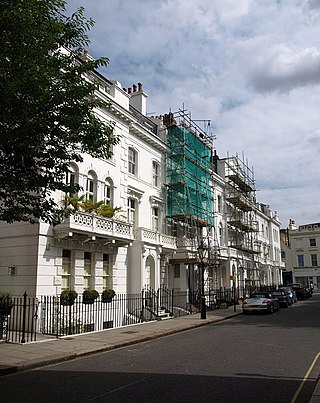
Hereford Square is a garden square in South Kensington, London SW7. It lies to the west of Gloucester Road, which forms the east side of the square. Wetherby Place is the western continuation, running off the north-west corner of the square.
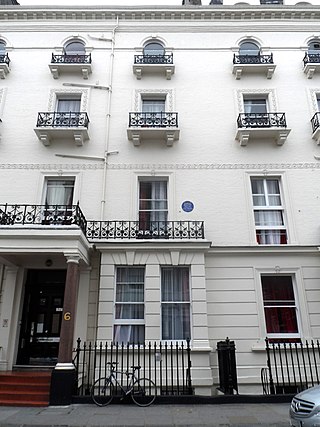
Grenville Place is a street in the Royal Borough of Kensington and Chelsea, London, that connects Cornwall Gardens and Launceston Place in the north with Cromwell Road in the south. It is crossed in its northern part by Cornwall Mews South, and joined on its western side by Emperor's Gate (twice). it is joined on its eastern side by Southwell Gardens.
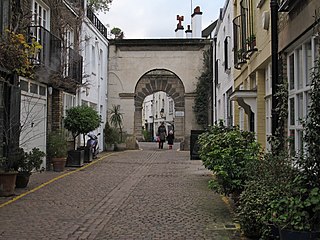
Kynance Mews is a mews street in South Kensington district of the Royal Borough of Kensington and Chelsea in London, SW7. The mews consists of 33 residential properties on a setted road that passes from Gloucester Road on the east, before being bisected by Launceston Place, with the western end of the mews ending in a cul-de-sac. The entrances to the mews pass through three arches, each listed Grade II on the National Heritage List for England. The arches were built c. 1860 to a design by Thomas Cundy III.
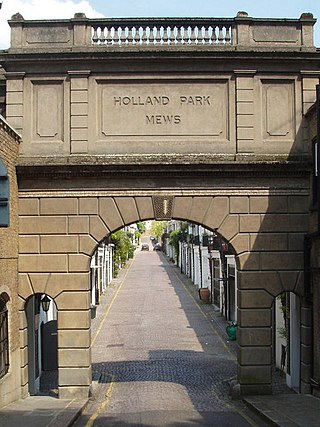
Holland Park Mews is a mews street in the Holland Park district of the Royal Borough of Kensington and Chelsea in London, W11. The mews consists of 67 residential properties, originally built as 68 stables, on a cobbled road with two entrances from Holland Park. The west entrance passes under an arch listed Grade II on the National Heritage List for England. The arch was built in 1862, and the stables from 1860 to 1879.

Kensington New Town is an area of housing in Kensington, London, which was developed in the early 19th century. It lies to the south of Kensington High Street and to the southwest of Kensington Gardens.

Montpelier Square is a residential garden square in Knightsbridge, London, administratively in the City of Westminster. The homes were built in the 19th century and are of brick construction partly covered by stucco. All of the buildings facing inwards are listed grade II in the heritage listing scheme used in England.



















